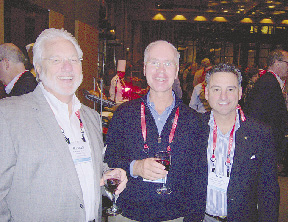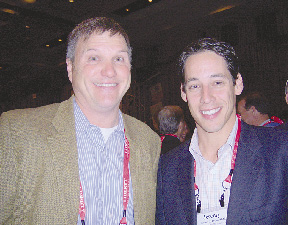The annual Fall Convention was held October 20-22 at the Hyatt Regency, 151 E. Wacker, downtown Chicago. The New England Chapter was well represented with the following members and Candidates: Tom Farrelly, Rob Nahigian, Bob Cleary, Greg Klemmer, Garry Holmes, Arlon Brown, Tom Sweeney, Don Mancini, Greg Cahill, Mike Garrido, Jim Boudrot, Jeremy Freid and Derek Losi.
The Opening General Session was on Thursday, October 20 with Jim Reeb from the Institute St. Onge and Bill Strauss of the Federal Reserve Bank of Chicago. In the past few decades, both the U.S. and world economies have experienced the concept of "offshoring" production and labor to countries all over the globe in search of lower cost labor. This experiment has worked for some companies and industries but, as we can recognize today, is not working for others. In this session, the panelists discussed the repositioning of global corporate expansion and the influx of "onshoring" in the U.S. and the impact on the U.S. and global economies.
Here is a summary of the Opening Session:
Bill Strauss, Senior Economist, Chicago Federal Reserve Bank
Strauss posed the question, "Is the U.S. losing its manufacturing base?" The quick answer is no and yes. U.S. has a growing manufacturing output base but is losing manufacturing jobs. It is doing more with less. The manufacturing output peaked in December 2007. Over two million industrial jobs were lost in the U.S. from 2008-2011. But he felt there was confusion on the question. He rephrased and asked "if we are looking at labor or output to the question?" If we are looking at manufacturing labor, then it should be known that manufacturing workers made up one out of every three workers in the U.S. after WWII. Now it's one out of ten workers so the trend does not look good and it's been flat over the last 60 years. Manufacturing jobs have been falling 3/10's of 1% on average. Jobs had been increasing from WWII to 1979 and then started to trend lower at
-1.6%. People are concerned that we are losing jobs to China. China has not been taking our jobs because it's been diminishing while the U.S. service industry has been increasing.
Manufacturing output has been rising 3.1% per year over the past 63 years or 600% since 1940. It has been driven by productivity and better efficiency. We are doing more with less but that translates into less labor. What it took 1,000 workers to produce in 1950 only takes 177 workers today. Manufacturing productivity has been growing faster over the past 40 years. The 1970s is where divergence in productivity occurred and it's apparent in durable manufacturing. Strong productivity growth allowed manufacturing sector to grow faster than the overall GDP.
Lower relative prices in the manufacturing sector have lead to manufacturing comprising a smaller share of the GDP over time. The value and prices of goods made has become cheaper and now become a smaller percent of GDP. Lessons from the farm sector can be learned. We are producing more in the farm sector than at any time in history with less than 2% of the U.S. employment. In 1870, 52% of the U.S. worked on a farm and now less than 2%.
Trade with China
China has risen to being the number one country of U.S. imports representing 19.1% of all U.S. exports in 2010. But China is the 3rd largest destination of U.S. exports as 7.2% of U.S. exports. China has recently increased the amount of goods flowing in the U.S. while Japan over the last 20 years is stable in its imports of U.S. products. The other issue is that many manufacturing parts are shipped from the U.S. to China for assembly. Then when reshipped back to the U.S. it is called an "import." But it is not an import.
Conclusion
Since July 2009, U.S. manufacturing output has increased 5.8% annually and recovered 52.8% of lost output. We have turned the corner. It has been a "V" shaped recovery. Manufacturing jobs have been rising but only with one out of eight workers. There's still a skill gap with retired workers as the most decline in manufacturing is cyclical and not structural. Profits in manufacturing have outperformed profits overall. Jim Reeb from the Institute St. Onge recommended that the aging babyboomers and the two billion additional middle income class in the next 20 years outside the U.S. will be good for 1) Health care, doctors, pharmaceuticals, retail medical and distributors 2) Consumer staples 3) Food and beverage especially energy drinks. Brand name companies are being outgrown by lesser known companies.










